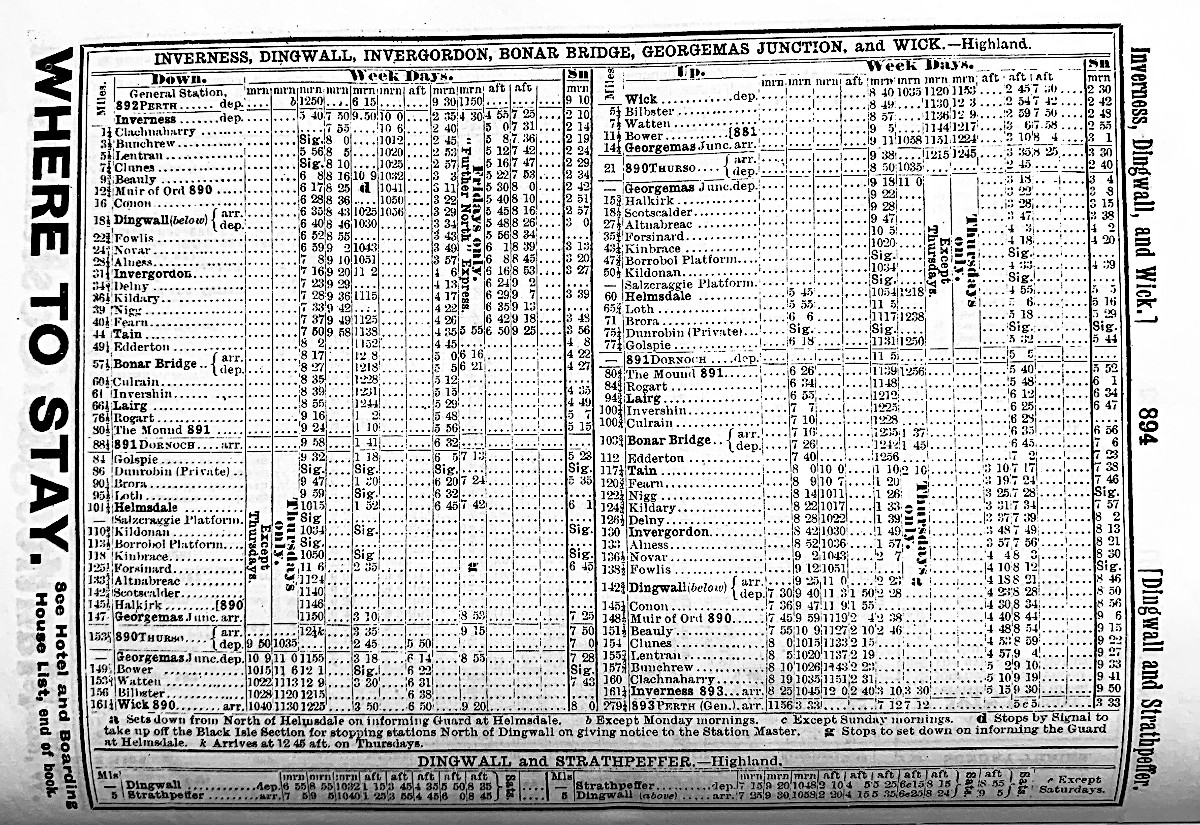| Re: OTD - 15th February (1917) - Jellicoe Express - first run Posted by grahame at 09:21, 15th February 2022 |     |
For the Far North section, here is the timetable from April 1910 - which I think is quite soon after the weekly "Further North Express" was added to the timetable. Shows the improvement in journey time possible by leaving out the small stations along the way

| Re: OTD - 15th February (1917) - Jellicoe Express - first run Posted by stuving at 00:37, 15th February 2022 |     |
The Dundee Courier, 26 July 1916, has a rather feeble patriotic piece about the fleet at Scapa Flow, and its recovery from Jutland. This says "the 'Jellicoe Express', as the sailors rather pleasantly and dutifully styled the extra fast train which carried them either way through the Highlands, was always one of the jolliest specials to travel with." Is that extra-fast, or just fast and an extra train? And how fast, relative to before and after the war?
'Before' is perhaps a better comparator, and I found times in a 1906 Bradshaw, though the imaged version is not all of one copy which is confusing. From Euston, there was no train direct to Inverness leaving before noon, but the "Corridor Luncheon and Dining Car Express" leaving at 2 pm arrived in Inverness at 5:10 am the next day. A connecting train to Thurso left at 5:40 and arrived at 12:15, having stopped everywhere (except Clachnaharry) which at the time was 36 stations.
Presumably that could be done lot quicker non-stop, but there are no examples. From Kings Cross, I can't see a real express, but the 5:15 am departure reaches Inverness at 8:35 pm, after the last train northwards. The time to Inverness is almost the same as that from Euston.
Taking those times as given, that took over 22 hours, so the Jellicoe Express was relatively slow. But from the reports it may have made at least one long stop (for breakfast), so maybe its performance was close to par for the time.
There is also a news item in that paper on 'The north of Scotland 'closed'", saying that "at Inverness Railway Station the checking of parties entering the area was carried out by Cameron Highlanders."
| Re: OTD - 15th February (1917) - Jellicoe Express - first run Posted by Mark A at 21:26, 14th February 2022 |     |
The 'Orcadian' may be a little to seek. Stromness to London if everything works and the Scrabster-Thurso station conundrum can be overcome, is a day's travel with a 6ish am start on the ferry and an arrival after 9pm in London. Northbound via Thurso = overnight, 'cos, ferry times.
Northbound via Aberdeen will on certain days give what is now an 11pm arrival on Orkney, at one time this would have been Stromness and earlier in the evening, it's now Hatston Pier. Either may be some way from one's eventual destination, Stromness had the advantage that it was the middle of 'Town'.
Mark
| OTD - 15th February (1917) - Jellicoe Express - first run Posted by grahame at 20:35, 14th February 2022 |     |
From London Remembers
From 1917, the Royal Navy train ran daily between London Euston and Thurso during both world wars. It was named after Admiral Sir John Jellicoe and carried service personnel to and from Naval bases around the country, including Scapa Flow. WW100 Scotland reports that in WW1 it ran 15 February 1917 - 30 April 1919.
It was estimated to have transported some half a million Service personnel during the two wars. (Helmsdale says half a million in each war). It was the longest scheduled rail service ever to run in the UK.
Crewe Station was one of the few scheduled stops on the 717-mile 21h 30m journey. This was a major refreshment stop, where over 300 women volunteers worked around the clock to provide refreshments in a canteen on Platform 6. Helmsdale was another refreshment stop.
It was estimated to have transported some half a million Service personnel during the two wars. (Helmsdale says half a million in each war). It was the longest scheduled rail service ever to run in the UK.
Crewe Station was one of the few scheduled stops on the 717-mile 21h 30m journey. This was a major refreshment stop, where over 300 women volunteers worked around the clock to provide refreshments in a canteen on Platform 6. Helmsdale was another refreshment stop.
also in the Orkney News
The train, a double locomotive, consisted of up to 14 carriages including sleeping quarters for officers and some compartments for prisoners. With such a long journey food was supplied for those travelling north to take up their deployment. Bagged teas were supplied to officers and at Inverness there was a sit down breakfast often catering for up to 460. An official refreshment stall at Dingwall served 134,864 cups of tea in this time.
On its route from Euston the train stopped only a few times to take on water ( steam trains in those days) and to allow men to be transported to other bases. Despite it being an incredibly long journey (700 miles) it kept very much to time.. It had a winter and summer timetable. In the summer leaving Euston at 6.30pm to arrive in Thurso the next day at 3.30pm. Comparing it to travel today by the same means there is very little difference in time taken.
Military Police frequently checked the train carriages which on the south bound route often contained survivors of shipwrecks.
In the winter snow was a problem and on 12th of January 1918 in a dreadful blizzard the Jellicoe Express and a rescuing snow plough became stuck a few miles outside of Thurso. The next day men walked into Thurso. It was a week before the line was cleared which meant running a train to Invergordon instead from where men were shipped north.
Delivering the mail to those serving on board the vessels of the Grand Fleet in Orkney was an extremely important function of the Jellicoe Express with sorting taking place on the northern part of the journey.
Once at Scapa Flow the Imperious became the Post Office where mail was sorted and delivered to the awaiting vessels. Something like 50,000 letters and parcels a day were sorted 80 million in total being delivered over the period. It provided banking facilities and also delivered English and Scottish newspapers – hot off the press which were sold, profits going to the war disabled.
The last run for the Jellicoe Express was on 30th of April 1919 until it was resurrected for duties in World War 2.
On its route from Euston the train stopped only a few times to take on water ( steam trains in those days) and to allow men to be transported to other bases. Despite it being an incredibly long journey (700 miles) it kept very much to time.. It had a winter and summer timetable. In the summer leaving Euston at 6.30pm to arrive in Thurso the next day at 3.30pm. Comparing it to travel today by the same means there is very little difference in time taken.
Military Police frequently checked the train carriages which on the south bound route often contained survivors of shipwrecks.
In the winter snow was a problem and on 12th of January 1918 in a dreadful blizzard the Jellicoe Express and a rescuing snow plough became stuck a few miles outside of Thurso. The next day men walked into Thurso. It was a week before the line was cleared which meant running a train to Invergordon instead from where men were shipped north.
Delivering the mail to those serving on board the vessels of the Grand Fleet in Orkney was an extremely important function of the Jellicoe Express with sorting taking place on the northern part of the journey.
Once at Scapa Flow the Imperious became the Post Office where mail was sorted and delivered to the awaiting vessels. Something like 50,000 letters and parcels a day were sorted 80 million in total being delivered over the period. It provided banking facilities and also delivered English and Scottish newspapers – hot off the press which were sold, profits going to the war disabled.
The last run for the Jellicoe Express was on 30th of April 1919 until it was resurrected for duties in World War 2.
And the BBC ... https://www.bbc.co.uk/news/uk-scotland-highlands-islands-48104327










